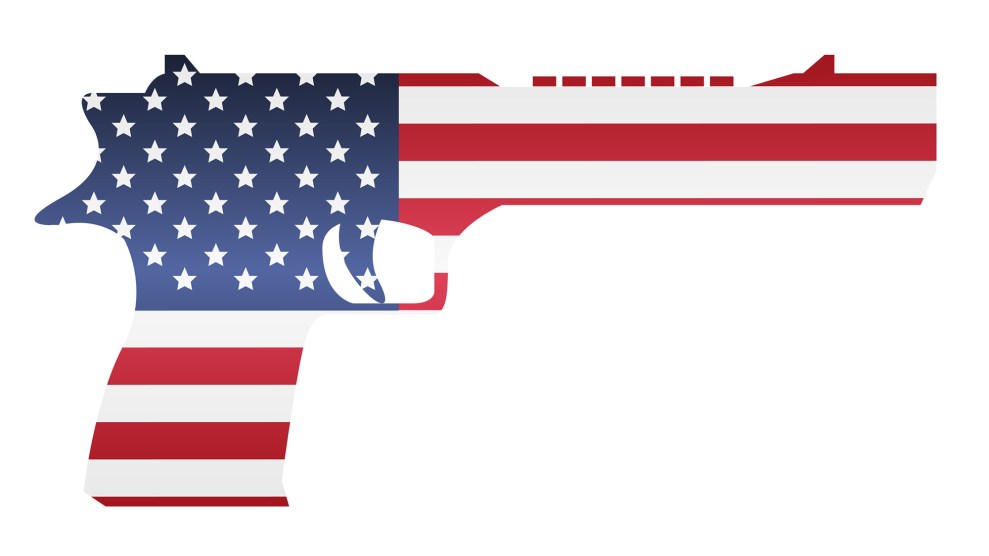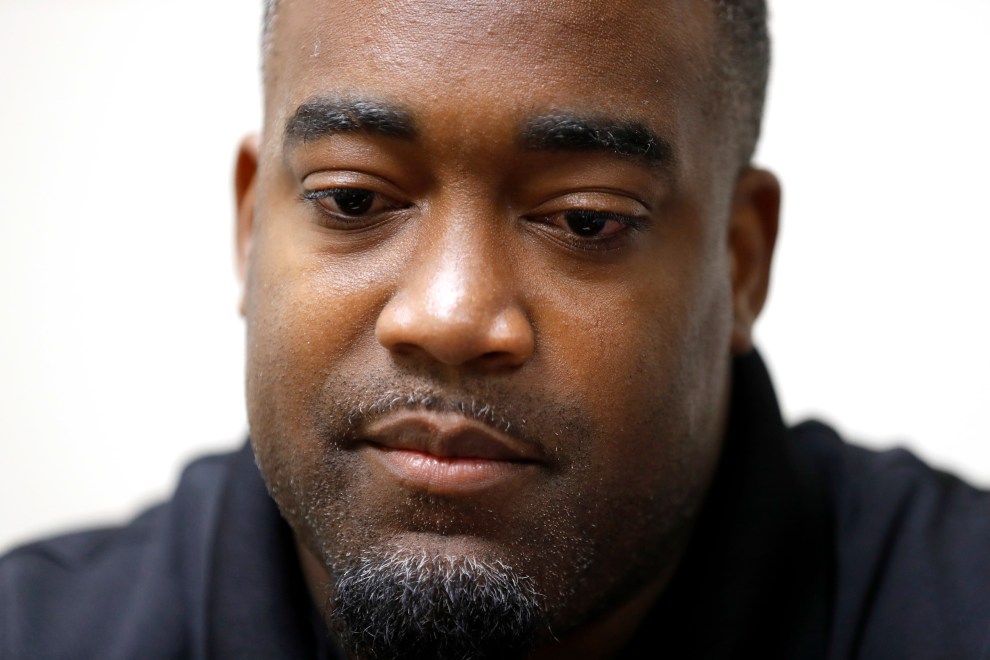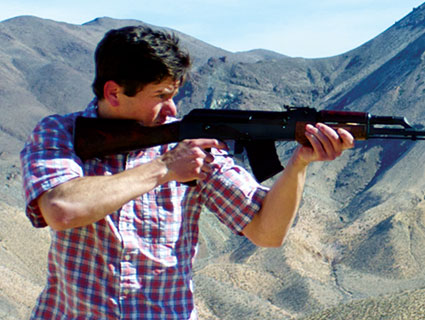
siiixth/Getty Images
This article first appeared on TomDispatch.com.
Guns. In a country with more than 300 million of them, a country that’s recently been swept up in a round of protests over the endless killing sprees they permit, you’d think I might have had more experience with them.
As it happens, I’ve held a gun only once in my life. I even fired it. I was in perhaps tenth grade and enamored with an Eagle Scout who loved war reenactments. On weekends, he and his friends camped out, took off their watches to get into the spirit of the War of 1812, and dressed in homemade muslin underclothes and itchy uniforms. I was there just one weekend. Somehow my pacifist parents signed off on letting their daughter spend the day with war reenactors. Someone lent me a period gown, brown and itchy and ill-fitting. We women and girls spent an hour twisting black gunpowder into newspaper scraps. I joked that the newspaper was anachronistic—the previous week’s Baltimore Sun—but no one laughed.
A man came by with a long gun, an antique, resting on the shoulder of his jerkin to collect our “bullets” and he must have read the gun terror written on my face.
“Wanna give it a try?” he asked.
“Sure,” I said, stumbling to my feet, pushing my gown out of the way, and trying to act like I didn’t have broken-rifle patches, symbols of the pacifist War Resisters League, all over my real clothes. I felt a surge of adrenaline as I took the heavy weapon in my way-too-small hands. He showed me how to wrestle it into position, aim it, and fire. There were no bullets, just one of my twists of powder, but it made a terrifying noise. I shrieked and came close to dropping the weapon.
And there it was: the beginning, middle, and end of my love affair with guns—less than a minute long. Still, my hands seemed to tingle for the rest of the afternoon and the smell of gunpowder lingered in my hair for days.
One in four Americans now owns a gun or lives in a household with guns. So how strange that, on that day in the late 1980s, I saw a real gun for the first and last time. I grew up in inner-city Baltimore. I’ve worked at soup kitchens and homeless shelters all over the East Coast and stayed at dozens of Catholic Worker Houses around the country—Providence, Camden, Syracuse, Detroit, Chicago, Los Angeles—every one in a “tough” neighborhood. I lived in Red Hook, Brooklyn, in the mid-1990s, before you could get a $4 coffee or a zucchini scone on Van Brunt Street, before there was an Ikea or a Fairway in the neighborhood. All those tough communities, those places where President Trump imagines scenes of continual “American carnage,” and I’ve never again seen a gun.
Still, people obviously own them and use them in staggering numbers and in all sorts of destructive ways. Sensing that they’re widespread beyond my imagination, my husband and I have started asking the parents of our kids’ school friends if they own guns when we arrange play dates or sleepovers. We learned this from the father of a classmate of my 11-year-old stepdaughter, Rosena. The dad called to make the arrangements for his son to come over after school. We talked logistics and food allergies and then he paused. “Now, I am sorry if this is intrusive,” he said, “but I do ask everyone: Do you keep guns in your house?” He sounded both uncomfortable and resolute.
I almost choked on my urge to say, “Don’t you know who I am?” In certain odd corners at least, my last name, Berrigan, is still synonymous with muscular pacifism and principled opposition to violence and weaponry of just about any kind, right up to the nuclear kind. But that dad probably didn’t even know my last name and it probably wouldn’t have meant a thing to him if he had. He just wanted to make sure his son was going to be safe and I was grateful that he asked—rather than just assuming, based on our Volvo-driving, thrift-shop-dressing, bumper-sticker-sporting lifestyle, that we didn’t.
“You know how kids are,” he said after I assured him that we were a gun-free household. “They’ll be into everything.”
And right he is. Kids are “into everything,” which is undoubtedly why so many of them end up with guns in their hands or bullets in their bodies.
“Do you question everyone about their guns?” I asked the dad. He replied that he did and, if they answered yes, then he’d ask whether those weapons were locked away, whether the ammunition was stored separately, and so on. “Thank you so much. I think we need to start doing that too,” I added as our conversation was ending, and indeed I have ever since.
It’s a subject worth raising, however awkward the conversation that follows may be, because two million kids in this country live in homes where guns are not stored safely and securely. So far this year, 59 kids have been hurt in gun accidents of one sort or another. On average, every 34 hours in our great nation a child is involved in an unintentional shooting incident, often with tragic consequences.
The National Rifle Association’s classic argument, “guns don’t kill people, people kill people,” takes on a far harsher edge when you’re talking about a seven-year-old accidentally killing his nine-year-old brother with a gun they found while playing in an empty neighboring house in Arboles, Colorado.
Two weeks after we learn this new parenting life skill in this oh-so-new century of ours, my husband Patrick is on the phone with a mom arranging a sleepover for Rosena. I hear him fumble his way through the gun question. From his responses, I assume the mom is acknowledging that they do have guns. Then there’s the sort of long, awkward silence that seems part and parcel of such conversations before Patrick finally says, “Well, okay, thanks for being so honest. I appreciate that.”
He hangs up and looks at me. “They do keep guns for hunting and protection, but they’re locked up and out of sight,” he tells me. “The mom says that the kids have never tried to get at the guns, but she understands the dangers.” (He had heard in her voice apology, embarrassment, and worry that the guns might mean no sleepover.)
I grimaced in a way that said: I don’t think Rosena should go, and he responded that he thought she should. The two of them then had a long conversation about what she should do and say if she sees a gun. She slept over and had a great time. A lesson in navigating difference, trusting our kid, and phew—no guns made an appearance. And now we know more about our neighbors and our community.
My son Seamus, five, received an Easter basket from a family friend. He was happy about the candy of course and immediately smitten with the stuffed bunny, but he was over the moon about what he called his new “carrot gun.” It wasn’t a toy gun at all, but a little basket that popped out a light ball when you pressed a button.
The idea was that you’d catch the ball, put it back in, and do it again. But that wasn’t the game my kids played. They promptly began popping it at each other. His little sister Madeline, four, was in tattle mode almost immediately. “Mom, Seamus is shooting me with his carrot gun!”
“Mom, Mom, Mom,” he responded quickly, “it’s a pretend play gun, not a real play gun. It’s okay.” He made popping noises with his mouth and held his hand as if he were grasping a genuine forbidden toy gun. It was an important distinction for him. He’d been a full-throated participant in the March for Our Lives in Boston on March 24, chanting with the rest of us “What do we want? Gun control! When do we want it? NOW!” for four hours straight.
At the march, he pointed out that all the police officers managing traffic and the flow of people were wearing guns on their belts. “I see a gun, Mom,” he kept saying, or “That police officer has a gun, Mom.”
Repeatedly, he noticed the means to kill—and then four days after that huge outpouring of youth-led activism for gun security, Stephon Clark was gunned down in his grandmother’s backyard in Sacramento, California. The police officers who shot him were looking for someone who had been breaking car windows in the neighborhood and they fired 20 shots into the dark in his direction. The independent autopsy found that he had been hit eight times, mostly in his back. Clark turned out to be holding only a cellphone, though the police evidently mistook it for a tool bar, which could have done them no harm from that distance, even if wielded as a weapon.
Maybe the police saw a weapon the same way my five-year-old son sees one. He can make a stick or just about anything else, including that little basket, into a “gun” and so evidently can the police. Police officers have killed black men and boys holding pipes, water hose nozzles, knives, and toy guns, too.
Parkland (17 killed, 14 wounded). Newtown (28 killed, 2 wounded). Columbine (15 killed, 21 injured). School shootings are now treated as a structural part of our lives. They have become a factor in school architecture, administrator training, city and state funding, and security plans. The expectation that something terrible will happen at school shapes the way that three- and four-year-olds are introduced to its culture. Part of their orientation now involves regular “shelter in place” and “secure-school” drills.
At my daughter’s preschool, the kids are told that they’re hiding from rabid raccoons, those animals standing in for marauding, disaffected white boys or men roaming the halls armed. As parents, we need to do more than blindly accept that these traumatic exercises are preparing our kids for the worst and helping them survive. Kids are vulnerable little beings and there are countless dangers out there, but they have a 1-in-600 million chance of dying in a school shooting. We endanger them so much more by texting while driving them home from school.
After every episode of violence at a school—or in the adult world at a church, night club, concert, movie theater, or workplace like San Bernardino’s Inland Regional Center or the YouTube headquarters—there’s always a huge chorus of “why?” Pundits look at the shooter’s history, his (it’s almost always a guy) trauma, and whatever might be known about his mental health. They speculate on his (or, in the rare case of those YouTube shootings, her) political leanings, racial hatreds, and ethnic background. The search for whys can lead to hand-wringing about hard-rock music or nihilistic video games or endemic bullying—which could indeed be factors in the drive to kill significant numbers of unsuspecting people—but never go far enough or deep enough.
Two questions are answered far too infrequently: Where do the guns come from? Where does violence come from?
Guns of all sizes and description are manufactured and sold in this country in remarkable numbers, far more than can be legally absorbed in our already gun-saturated land, so thousands of them move instead into the gray and black markets. Evidence of this trend shows up repeatedly in Mexico, where 70 percent of the weapons seized in crimes between 2009 and 2014 turned out to be made in el norte. We have an estimated 300 million guns in this country, making us, by far, first in the world in gun ownership—and some of those guns couldn’t conceivably be used for “hunting.” They are military-style weapons meant to tear human flesh and nothing but—like the AR-15 that 19-year-old Nikolas Cruz bought legally and used in his grim Parkland spree.
This country, in other words, is a cornucopia of guns, which—honestly, folks—doesn’t have a damn thing to do with the Second Amendment.
Where does the violence come from? I’ve already shared my inexperience with guns. Now, let me add to it my inexperience with violence. I don’t know what it’s like to have to react in a split second to, or flee from, an advancing perpetrator. No one has ever come at me with a gun or a knife or a pipe, or anything else. And I count myself lucky for that. In a nation in which, in 2016 alone, 14,925 people were killed by gun violence and another 22,938 used a gun to kill themselves, it’s a significant thing to be able to say.
And yet, I know that I’m the product of violence (as well as the urge, in my own family, to protest and stop it): the violence of white privilege, the violence of American colonialism, the violence of American superpowerdom on a global scale. And that’s no small thing. It’s a lot easier to blame active-shooter scenarios on poor mental-health screening than on growing up in a world layered with the threat of pervasive violence.
Power is about never having to say you’re sorry, never being held accountable. And that’s hardly just a matter of police officers shooting black men and boys; it’s about the way in which this country is insulated from international opprobrium by its trillion-dollar national security state, a military that doesn’t hesitate to divide the world into seven US “commands,” and a massive, planet-obliterating nuclear arsenal.
And don’t think that any of that’s just a reflection of Trumpian bombast and brutality. That same sense of never having to say you’re sorry at a global level undergirded Barack Obama’s urbane dispassion, George Bush Junior’s silver-spoon cluelessness, Bill Clinton’s folksy accessibility, George Bush Senior’s patrician poshness, Ronald Reagan’s aura of Hollywood charm, and Jimmy Carter’s southern version of the same. We’re talking about weapons systems designed to rain down a magnitude of terror unimaginable to the Nikolas Cruzes, Dylann Roofs, and Adam Lanzas of the world.
And it doesn’t even make us safe! All that money, all that knowledge, all that power put into the designing and displaying of weapons of mass destruction and we remain remarkably vulnerable as a nation. After all, in schools, homes, offices, neighborhoods across the country, we are being killed by our kids, our friends, our lovers, our police officers, our crumbling roads and bridges, our derailing trains. And then, of course, there are all those guns. Guns meant to destroy. Guns beyond counting.
So what might actually make us safer? After all, people theoretically buy the kind of firepower you might otherwise use only in war and pledge allegiance to the US war machine in search of some chimera of safety. And yet, despite that other classic NRA line—“The only way to stop a bad guy with a gun is with a good guy with a gun”—are we truly safer in a nation awash in such weaponry, with so many scrambling in a state of incipient panic to buy yet more? Are my kids truly on the way to a better life as they practice cowering in their cubbies in darkened classrooms for fear of invading rabid “raccoons”?
Don’t you think that true security lies not in our arming ourselves to the teeth against other people—that is, in our disconnection from them—but in our connection to them, to the web of mutuality that has bound societies, small and large, for millennia? Don’t you think that we would be more secure and so much less terrified if we found ways to acknowledge and share our relative abundance to meet the needs of others? In a world awash in guns and fears, doesn’t our security have to involve trust and courage and always be (at best) a work in progress?
As for me, I’m tackling that work in progress in whatever ways I can—with my neighbors, my town, my husband, and most of all my children, educating them in the ways violence scars and all those weapons just increase our journey into hell, never delivering the security they promise.















